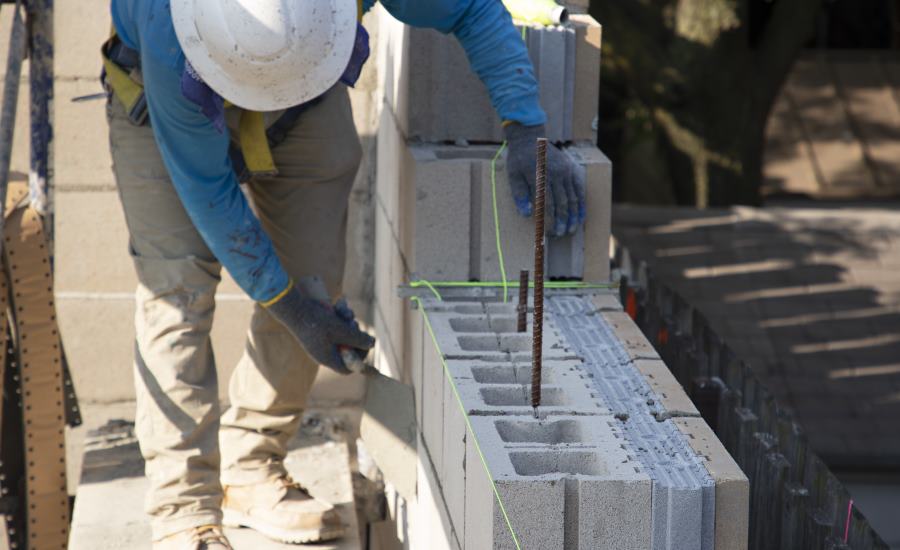Insulated Concrete Masonry Units Save Construction Time






On the streets of the South Bronx, the long-forgotten clamor of construction noise fills the air. To local residents, that disharmony sounds like the sweet melody of progress and hope. Most New York City dwellers would agree that of the city’s five boroughs, the Bronx has struggled the most with high crime rates, poverty, and stagnated growth. But fortunes are shifting for this previously overlooked section of the city. Fueled by renewed local pride and an affordable housing shortage, an economic and cultural resurgence is taking place in the Bronx.
Baez Hughes Development has been at the forefront of the city’s affordable housing efforts, and the contractors have most recently broken ground on Valdesia Gardens in the South Bronx’s Longwood neighborhood. Vice President Emanuel Kambanis, AIA, is the architect and general contractor for a much-anticipated 7-story, forty-five-unit apartment complex being constructed on Prospect Street. Kambanis, like other contractors, is under constant pressure to keep up with timelines while tackling the inevitable obstacles encountered in a high-density city like New York.
The Valdesia Gardens job is “a ground up project” according to the builder. As the structure gains height, the process grows more complicated. “The greatest challenge is being two inches from the building next door and managing the brick and scaffolding in outside areas. When you have to lay block from the inside rather than outside and have scaffolding on another’s property, there are added insurance costs,” said Kambanis. With such close proximity to the adjacent building, Kambanis finds that traditional masonry is not a viable option, so he is making the bold decision to switch from traditional masonry to Echelon’s InsulTech Insulated Concrete Masonry Units (ICMU).
Kambanis explains, “The InsulTech System has the structural and thermal properties all in one system—block, insulation, air & moisture barrier and finished face—making them ideal for working from the inside of a structure.” This complete system is proving essential in overcoming some of the Valdesia site’s more difficult hindrances. Kambanis notes, “Energy codes demand we insulate the entire envelope – that means insulating and waterproofing the entire building. InsulTech™ actually has the continuous insulation, moisture drainage, and air barrier we need to be in compliance.”
In contrast, meeting these same standards with traditional masonry is much more involved and time-consuming. Kambanis laments, “You have to install all the clips for the brick support as you go up – and it’s a challenge to waterproof the block with a liquid on the outside. You never get 100 percent coverage.”
Like all New York City contractors, Kambanis also has to consider the limited space available and weather variables. With old-fashioned masonry, he adds, “You also need scaffolding on the outside – then start your brick work, weep holes, air gap etc. Also, it’s wide open so when masons work with mortar, they need mesh to protect the air gap. You can imagine the extra labor – a particular pain when you consider the high cost of labor in NYC!”
“With this product, you get a three-in-one product that includes the insulation layer – you’ve got thermal performance, R Values, moisture resistance all in one unit plus aesthetic outer face,” explains Kambanis. “With these efficiencies, we’re able to get 15 percent back in energy rebates, which gave me more design freedom to put design elements back into the building such as high energy windows. We add quality and even more energy savings on top of the energy savings.”
Kambanis stresses the importance of the embedded insulation. “Every project in New York City has to pass an energy audit for continuous insulation on the exterior.” With the Longwood inspection, Kambanis had an unexpected experience. He recalls, “The energy audit inspector was very happy and surprised – he learned a lot about InsulTech and was impressed. He had never seen it before, and most inspectors know envelope and insulation products. This is how word spreads, when they start recommending it.”
Because they’re a novel system, some instruction is required to get masons up and running, so Echelon routinely provides on-site assistance to developers. As the general Contractor on the jobsite, installation is one of Emanuel’s responsibilities.
“The Echelon reps came to the site to explain the ICMU installation to our crew,” he said. “The training was great. Len Browning, lead technical advisor and Dan Suchovic, architectural sales representative, were there to help build a mock-up panel with the team to get them acquainted with the system.” Kambanis recalls, “We did dry runs on exterior pieces,” which included the ICMU’s Half-High units, designed with all the features and benefits of the full unit, but with the aesthetic of jumbo brick.
“We can achieve the linear brick look at half the cost—it makes a huge difference, using the taller profiles where you can’t see, but then the half high on the visual areas in the front elevations.”
In New York City’s competitive construction market, efficiencies and time management are critical to remaining profitable. To stay relevant, Kambanis and associates are tuned into current developments in the affordable housing market. “The Longwood project is HPD subsidized. As developers, we were familiar with the approval process; we approached HPD with a plan to keep it affordable,” the builder explains.
Affordable housing guidelines fall under the purview of New York City’s Housing Preservation and Development (HPD) department, which uses Area Median Income (AMI) as criteria for qualifying. Calculated by the U.S. Department of Housing and Urban Development (HUD), AMI is determined by documenting all of a city’s salaries and identifying the exact midpoint. For example, according to the website nyc.gov, New York City’s AMI for 2019 is just over $96,000, which means that half of the city’s salaries fall below that number and half are above it.
Of the 44 affordable units on Prospect Street, 16 units will be available to households earning up to 70 percent of the Area Median Income (AMI) while 28 units will be designated for households earning up to 90 percent of the AMI. Both are categorized as moderate-income levels, and subsequent rents are determined as a percentage of salary – ideally 30 percent or less than the resident’s total salary. That qualifier, however, does not guarantee access. These much sought-after units are allocated based on housing lotteries; the city’s overall supply of affordable housing falls far short of the demand. The reality is that contractors can’t build these structures fast enough.
For Kambanis’ Valdesia affordable housing project, the ICMUs make all the difference. “InsulTech speeds up the job and is much faster than block and brick. Overall, we think the product will save us about six months of time – with an early 2020 targeted completion date. We are already trying to plan InsulTech for our next affordable housing project. We will be able to document speed much more accurately because we will be using it from the start,” said Kambanis, adding, “I like the product, crew and all the support we’ve had throughout the process.”
To learn more, visit www.EchelonMasonry.com.
Looking for a reprint of this article?
From high-res PDFs to custom plaques, order your copy today!





.png?height=200&t=1741613241&width=200)



